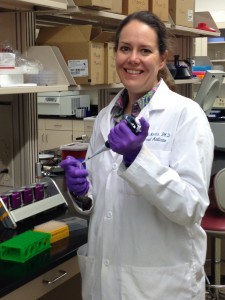Investigator Spotlight: August 2014

Margaret Morris, PhD
Dr. Morris is an assistant professor, working with Dr. Jerry Nadler at Eastern Virginia Medical School.
-
Tell us about your education and background – where are you from, where did you go to school?
I grew up in Dallas, Texas. I attended the Texas Academy of Math and Science at the University of North Texas, and then I transferred to the University of Michigan, where I finished my B.S. in Biology. I returned to Dallas for my graduate studies in Immunology at the University of Texas Southwestern Medical Center at Dallas. After completing my PhD, I moved to the University of Virginia to pursue postdoctoral studies in the laboratories of Drs. Klaus Ley and Jerry Nadler.
- Where do you currently work and what is your position? What does a “day in the life” look like for you?
In 2008, I moved to Eastern Virginia Medical School with Dr. Nadler’s group, and I am now an Assistant Professor. I don’t have a “typical” day. Some days, I spend the entire day in the lab doing experiments, while other days, I am stationed at my computer working on grants or sitting in on conference calls. - Why diabetes? How did you get involved in diabetes and/or what made you want to work in diabetes research?
My personal interest in type 1 diabetes (T1D) began with a friendship, as my best friend in graduate school was diagnosed at age 12. She has been fortunate to maintain her health. My involvement in diabetes research evolved further due to the strong research environment at the University of Virginia. - Tell us about your research.
I am involved in several different aspects of diabetes research. For my research interests outside of nPOD, I study an enzyme that leads to the generation of inflammation. This enzyme, 12-lipoxygenase, is expressed in pancreatic islets. In the absence of this enzyme, diabetes prone-NOD mice are protected from developing diabetes. I am trying to figure out exactly how the enzyme and its products contribute to diabetes development, and in collaboration with Dr. Nadler, we are trying to characterize inhibitors of this enzyme that may be useful as future therapeutic modalities. I am also involved in several nPOD studies. My studies using nPOD tissues are three-fold. I am investigating the expression of 12-lipoxygenase in human pancreas tissues, which will help as we look at moving the 12-lipoxygenase inhibitors into the clinic. I also recently received a grant from the JDRF to look for novel biomarkers (proteins that signal disease) in the pancreas of T1D donors as compared to non-diabetic donors, which will be done in collaboration with Drs. Julius Nyalwidhe and Jerry Nadler. These studies will complement the studies that the three of us are involved in for the nPOD-Viral Working Group project. Both of these investigations utilize exciting new technologies in the proteomics field to analyze human tissues for viral proteins and other proteins that might help us determine new means of earlier diabetes detection. -
What are your thoughts on the progress being made in T1D research as a whole?
I am very excited about some current research areas, especially inflammation, the gut microbiome, and investigations into viral initiation of T1D. While I think much progress has been made, I feel that we still have a long way to go. I feel that it is very difficult to try and treat, prevent, or cure T1D when we don’t know exactly how the disease is initiated.
- Why is diabetes research so important?
The incidence, diabetes, is on the rise, and the cost of treating those with diabetes is also increasing. Diabetes research has the power to potentially alter the course of disease progression, but we need to have a better understanding of what causes the disease, and how we can prevent the disease. I firmly believe that studies, such as those being done by the nPOD-Viral Working Group, have the potential to radically change our understanding of the disease process, and lead to improvements in patient care. - Do you have anything extra you would like to share? Is there anyone to thank or acknowledge?
I’d like to thank both the JDRF and the ADA, as both organizations have played a pivotal role in supporting my research since I was a postdoctoral fellow. These funds are vital to many scientists, especially given the current funding climate. I am also grateful to the families that have a great future vision, and have a desire for their loved ones to leave a lasting legacy. Although we never know these family members, their selflessness enables us as researchers to answer more questions, and hopefully find answers about diabetes development for those who are still living. - When you’re not working, what do you like to do for fun?
I love to sing, and am currently trying to gather other nPOD musicians together for some fun and entertainment at future meetings. I mainly sing classical music (opera/oratorio style), and have been to Carnegie Hall twice with the Dallas Symphony Chorus while I was in graduate school, and I have also been honored to sing the National Anthem at EVMS graduations. I also love to knit, cook, bake and ride my bicycle. I also have two young daughters that keep me quite busy!
